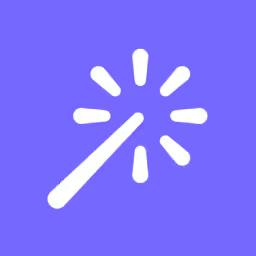
Tired of sending emails at odd hours or forgetting important follow-ups? Outlook’s schedule send feature lets you draft messages anytime and deliver them exactly when timing matters. Setup takes less than 30 seconds.
The only trick is knowing which method matches your Outlook version. Microsoft has three: Classic, New, and Outlook Web, each with a different process. This guide breaks them down step by step, with troubleshooting tips to keep your scheduled emails right on track.
What you'll accomplish:
- Master email scheduling across all three Outlook platforms
- Send professionally timed messages that improve response rates
- Maintain work-life boundaries without sacrificing productivity
- Never forget important follow-ups again
- Look like the organized professional you are (even in pajamas at midnight)
Why Email Scheduling Matters for Professionals
Before diving into the technical steps, understanding the strategic value of email scheduling will transform how you think about professional communication. The difference between good and great communicators often comes down to timing, not just content.
Perfect timing separates amateur communicators from professionals. Research shows emails sent during peak business hours (9-11 AM and 1-3 PM) achieve significantly higher open and response rates than messages sent at random times.
Email scheduling solves three critical problems:
- Professional Boundaries: Compose emails during your productive hours without disturbing colleagues after business hours. No more worried responses asking "Are you okay? It's 3 AM!"
- Global Coordination: Working with international teams? Schedule your message to arrive during their business hours, not when they're sleeping.
- Strategic Timing: Tuesday through Thursday emails perform best, while Monday mornings get buried in weekend overflow and Friday afternoons compete with weekend planning.
- Never Forget Again: Write follow-ups immediately after meetings, then schedule delivery for the perfect follow-up timeframe. Your future self will thank you.
Quick Reference: Platform Comparison
Before diving into detailed instructions, here's an at-a-glance comparison to help you choose the right method for your Outlook version:
For comprehensive strategies on boosting your overall email productivity beyond just scheduling, explore our detailed guide with proven techniques and tools.
Schedule Email in Classic Outlook: Complete Guide
When you need more granular control over your email timing or want to set organization-wide delays, the traditional Delay Delivery feature offers advanced options that Schedule Send doesn't provide.
For more control, use the traditional delay delivery option:
- Step 1: Compose your email normally.
- Step 2: Click the "Options" tab in the ribbon.
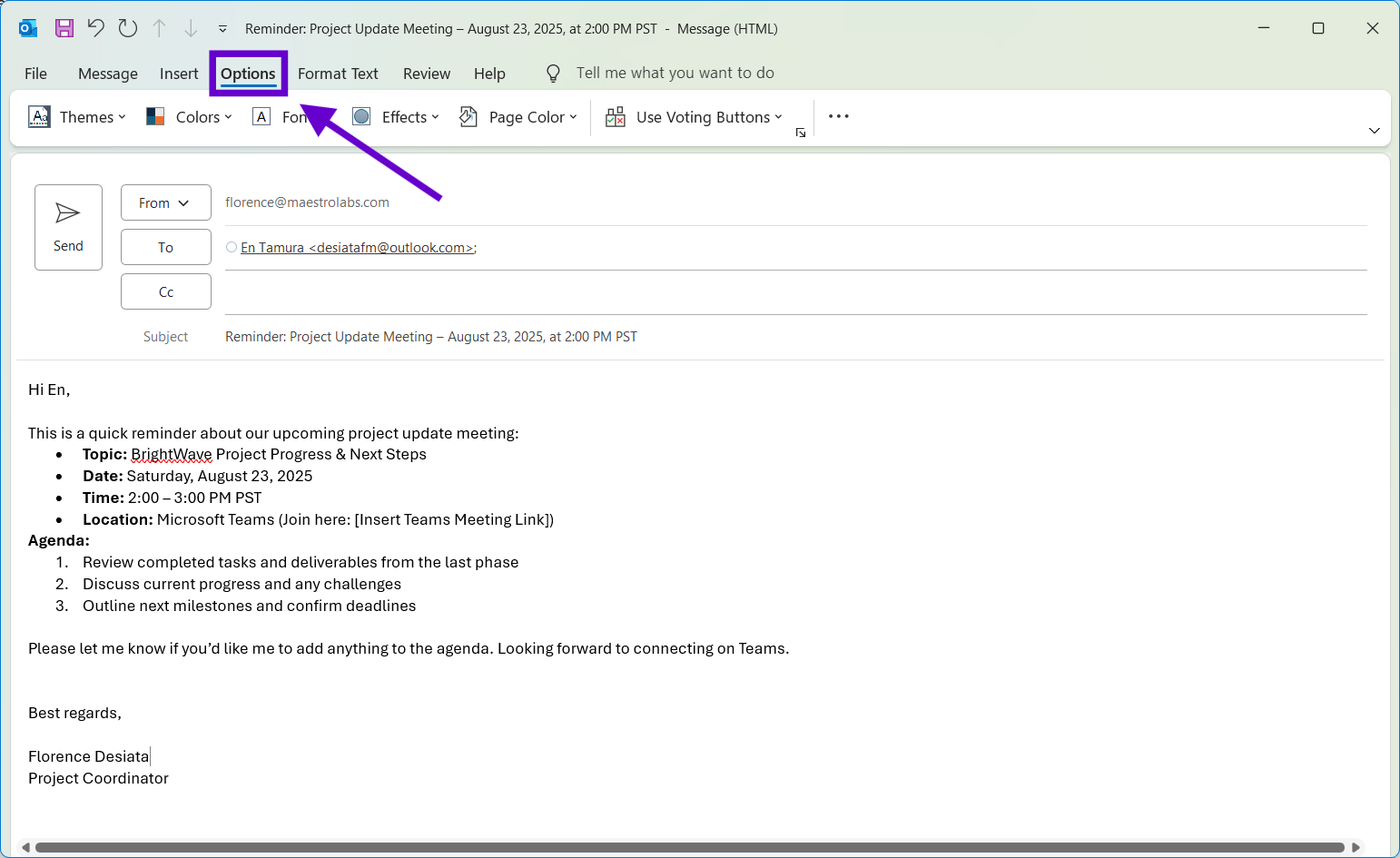
- Step 3: Select "Delay Delivery" from the More Options group.
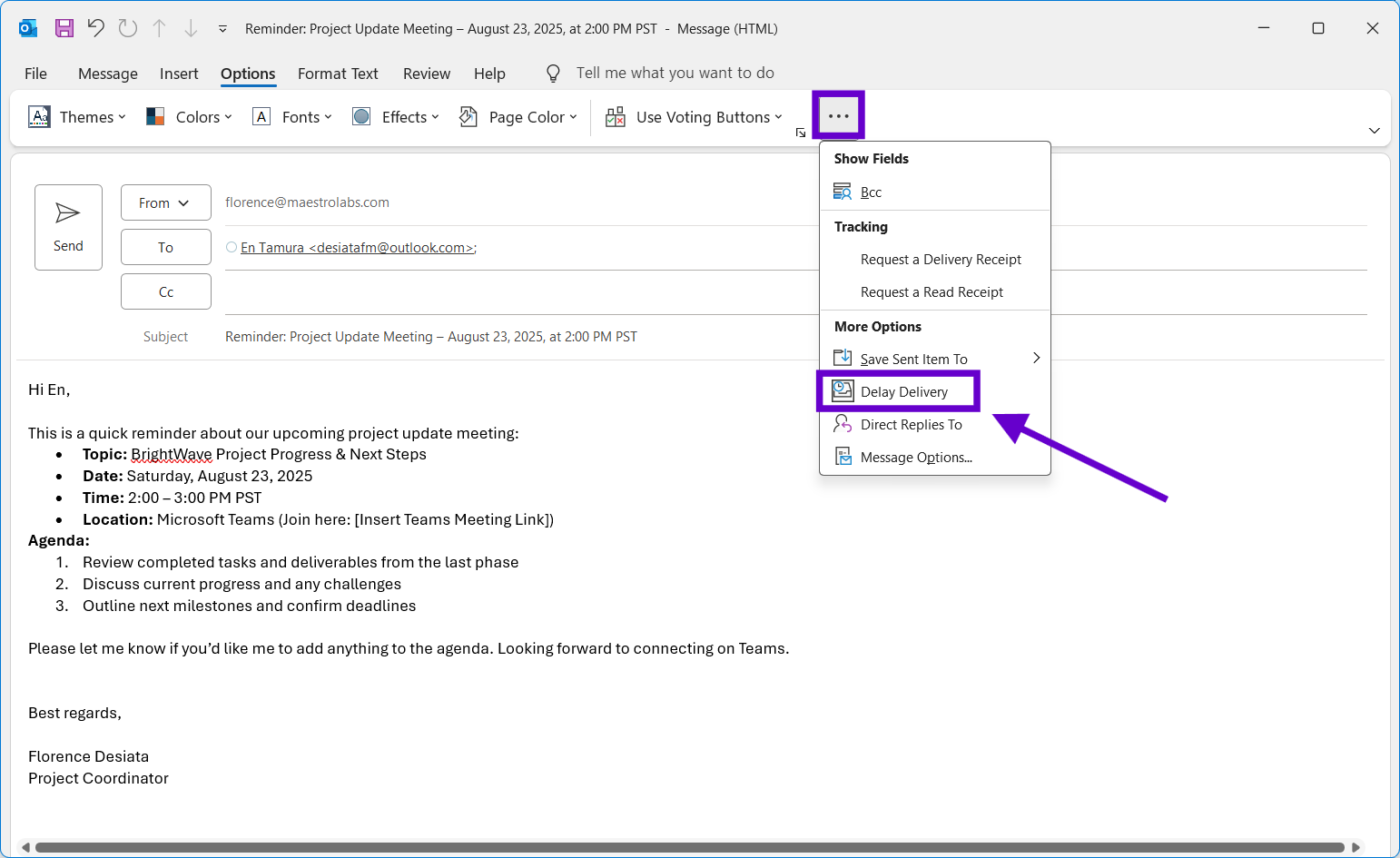
- Step 4: Check "Do not deliver before" and set your desired date and time.
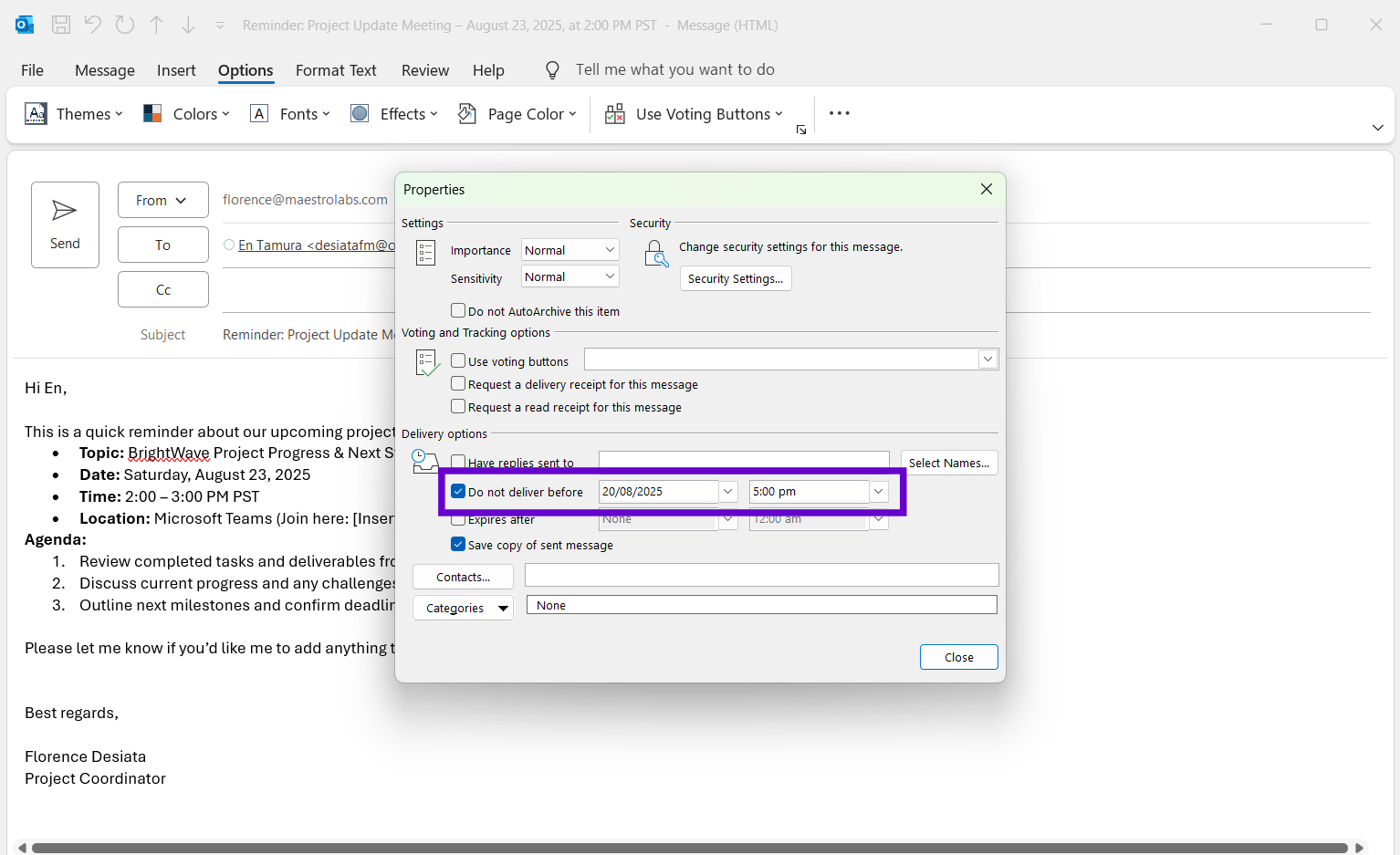
- Step 5: Click "Close" then "Send". The email sits in your Outbox until the scheduled time.
Important: Classic Outlook must be running and connected to the internet for scheduled emails to send. If your computer is off or disconnected, emails won't send until you're back online.
Schedule Email in New Outlook: Streamlined Process
Moving from Classic Outlook's traditional approach, New Outlook represents Microsoft's vision for modern email management. The streamlined interface prioritizes ease of use while maintaining powerful scheduling capabilities that sync seamlessly across all your devices.
New Outlook streamlines scheduling with an intuitive interface that makes timing your emails effortless.
- Step 1: Click "New mail" and compose your message completely.
- Step 2: Find the "Schedule send" option beside the Send button (may appear as a dropdown arrow).
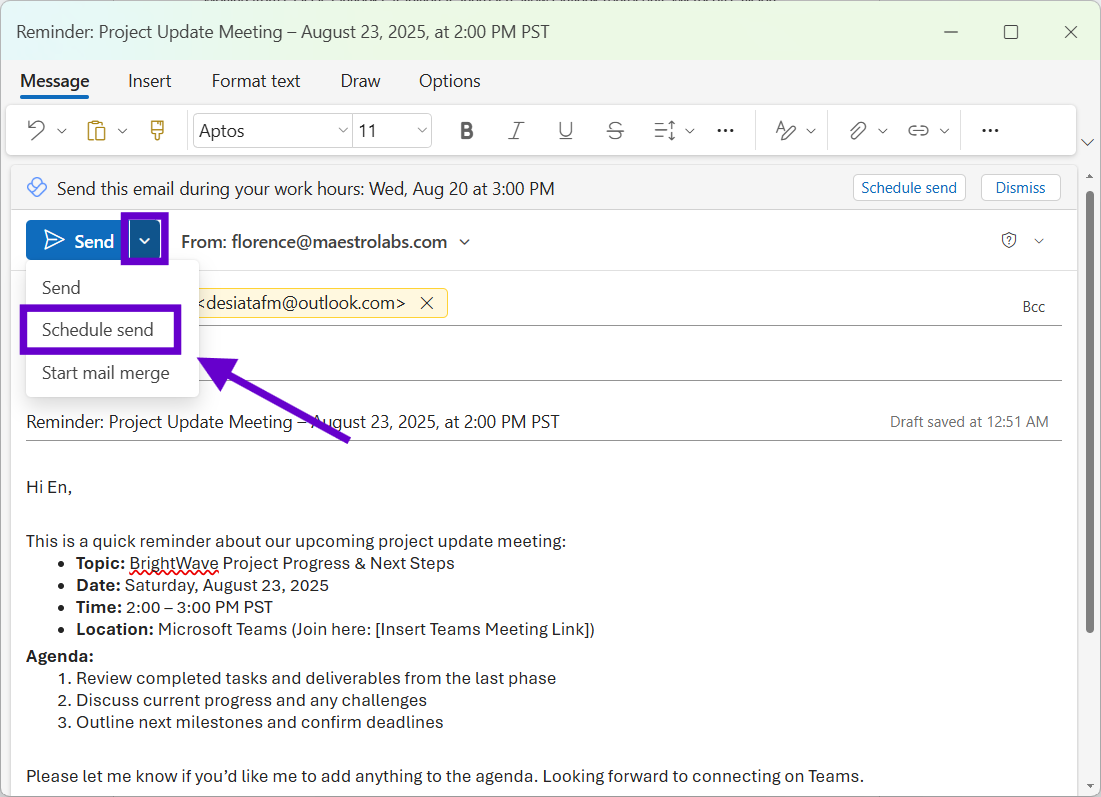
- Step 3: Select from smart suggestions:
- Tomorrow morning (Thursday 8:00 am)
- Sunday morning (Sunday 8:00 am)
- Custom time (your choice)
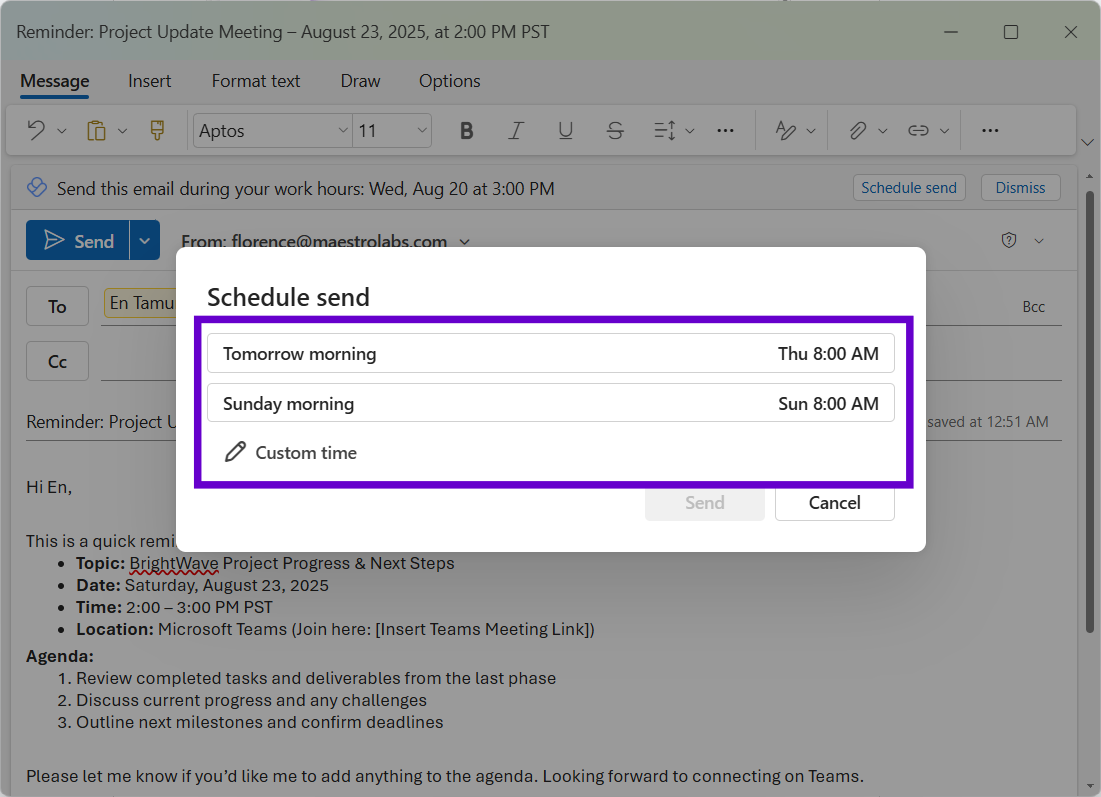
- Step 4: To set a custom time, select the desired date from the calendar and the time from the dropdown menu.
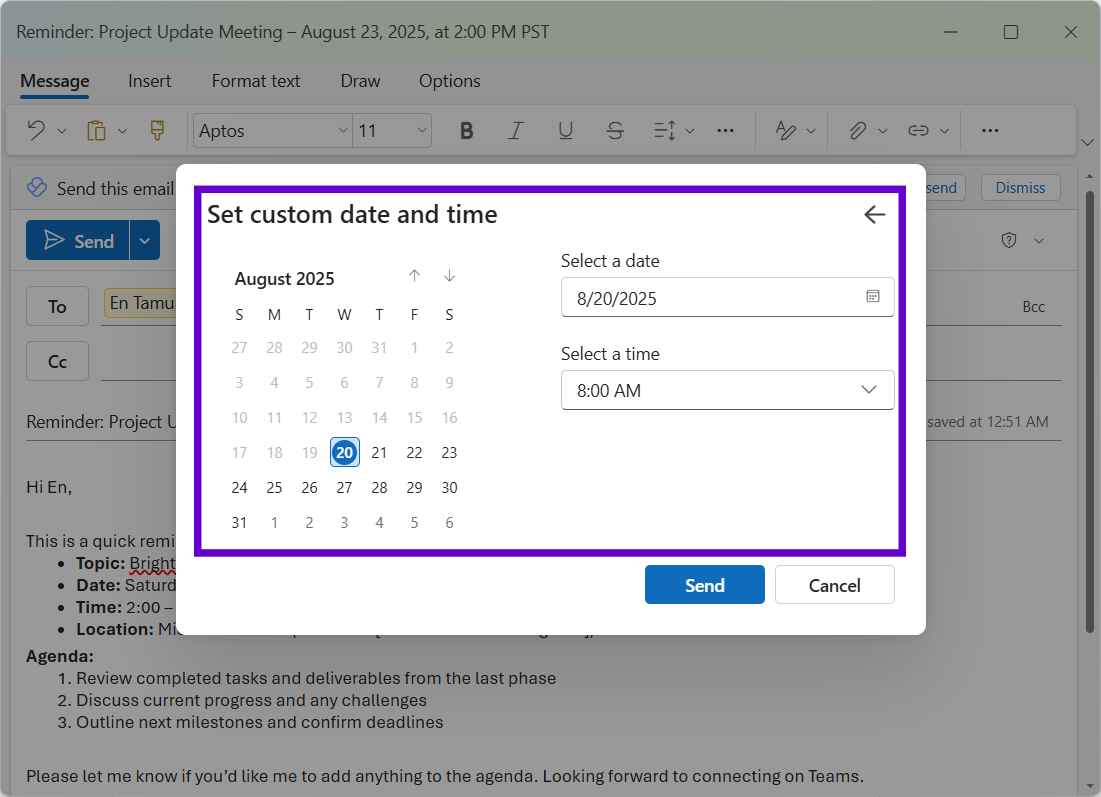
- Step 5: Click "Send" to schedule. Your message appears in Drafts with delivery information.
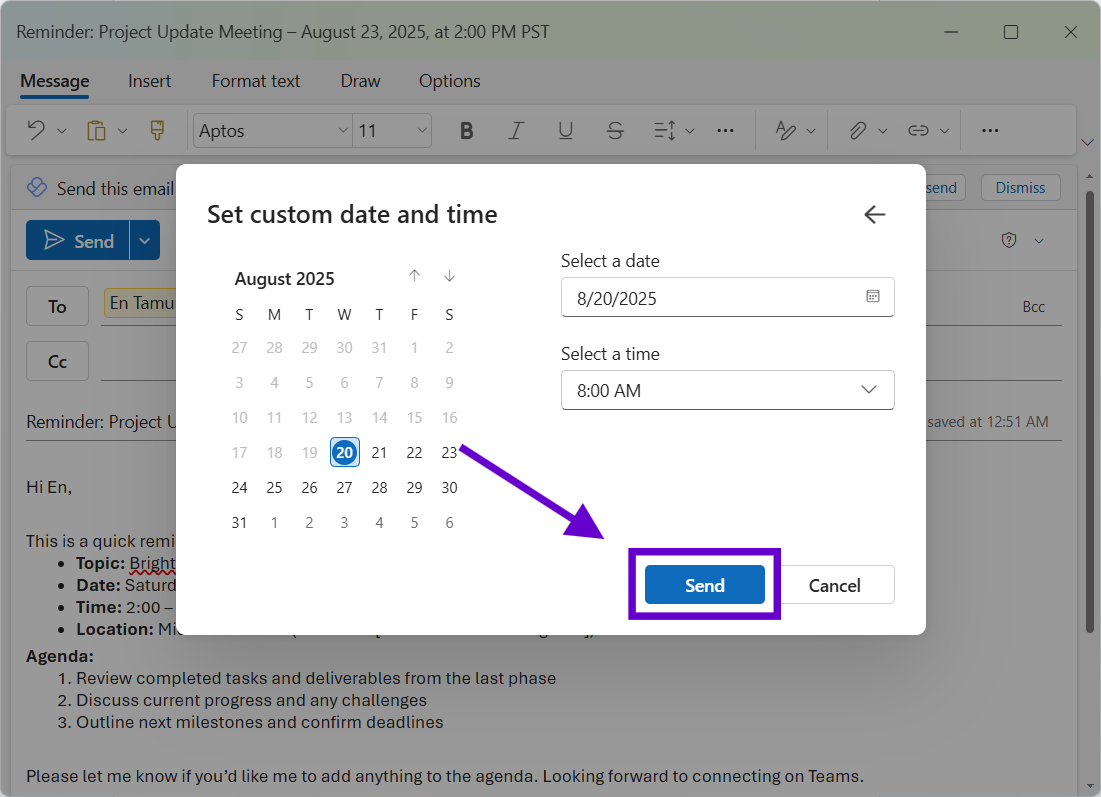
Advantage: New Outlook syncs across all your devices automatically. Schedule on your computer, edit on your phone.
To further enhance your New Outlook experience with AI-powered features, explore our guide on using AI in Outlook for smarter email composition and scheduling optimization.
Schedule Email in Outlook Web: Universal Access
Transitioning from desktop applications to browser-based solutions, Outlook Web offers the ultimate flexibility for email scheduling. This platform excels when you need reliable scheduling across multiple devices, locations, or operating systems without software installation requirements.
Outlook Web provides universal scheduling access from any browser, perfect for users who work across multiple devices.
- Step 1: Navigate to outlook.live.com or your organization's portal and sign in.
- Step 2: Click "New message" and compose your email fully.
- Step 3: Select the dropdown next to the Send button and select "Schedule send".

- Step 4: Choose from options:
- Tomorrow morning (Thursday 8:00 AM)
- Sunday morning (Sunday 8:00 AM)
- Custom time
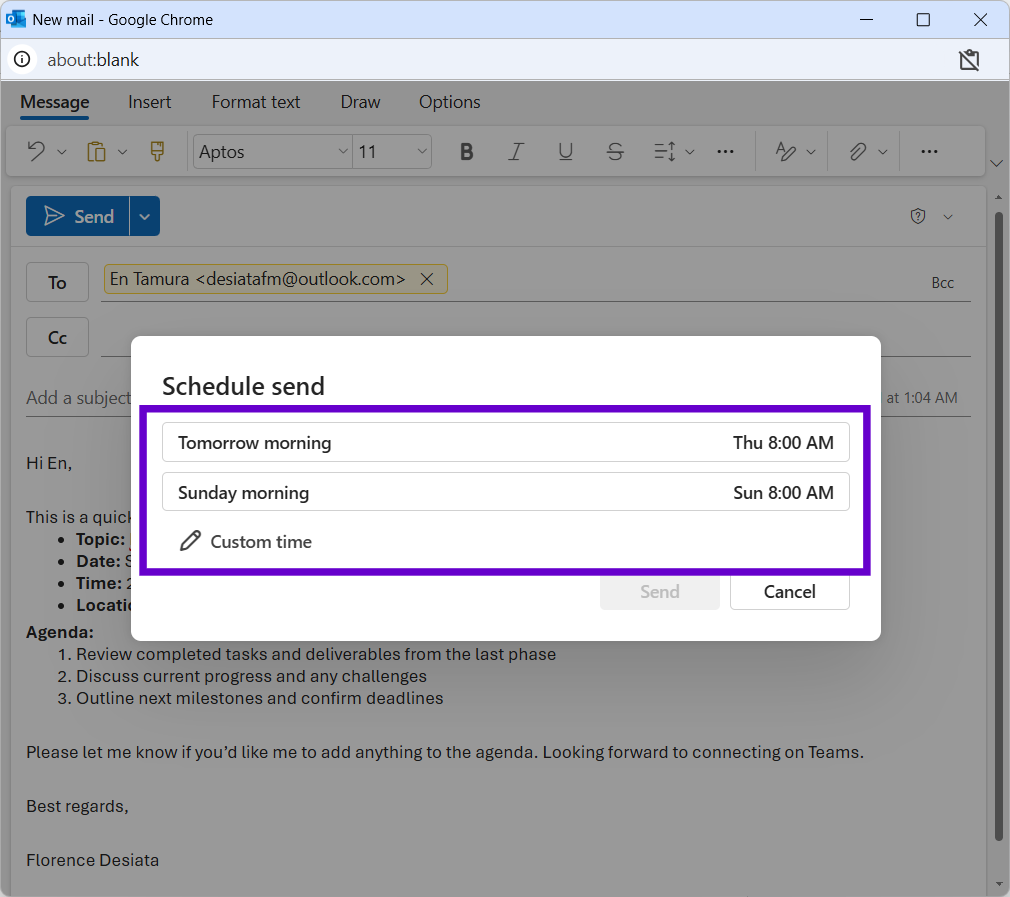
- Step 5: For custom timing, select the desired date and time, then click "Send".
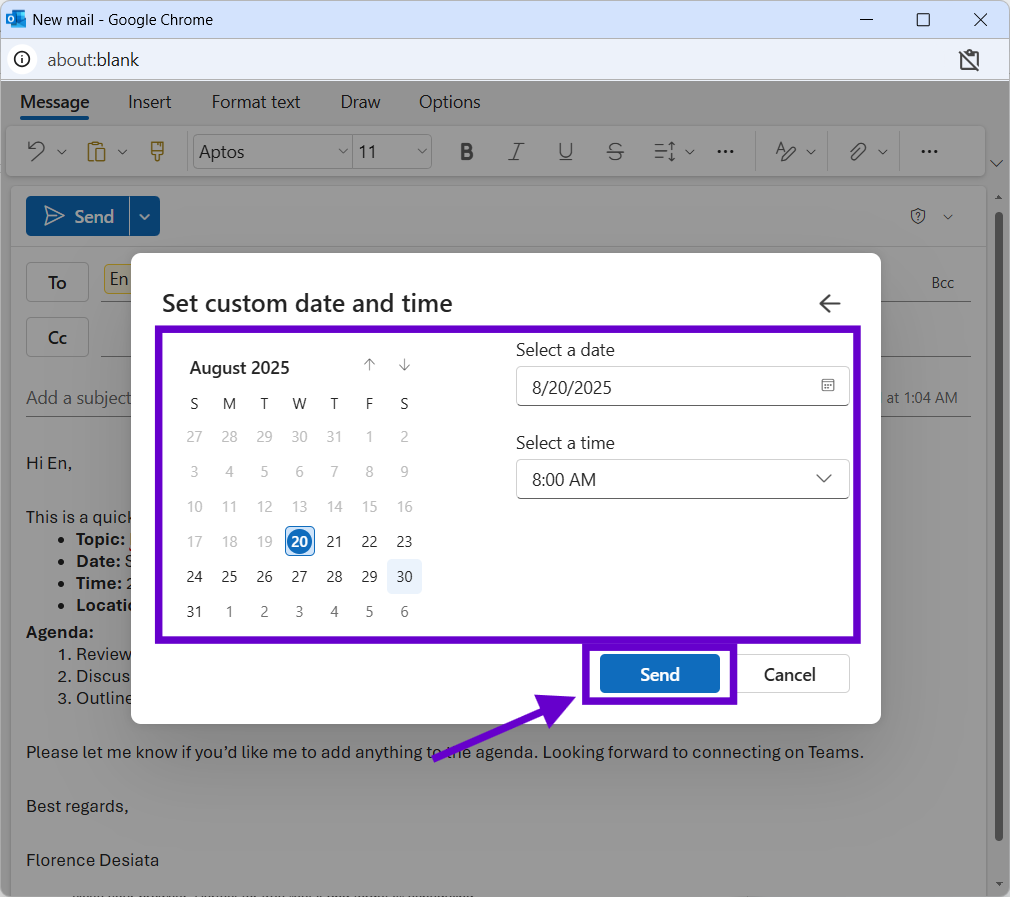
Benefits: Web Outlook sends from Microsoft's servers, so emails are delivered even if you close your browser. Perfect for true "set it and forget it" scheduling.
For comprehensive strategies on managing your Outlook inbox effectively across all platforms, including organizing scheduled emails and follow-ups, check out our detailed productivity guide.
Managing Your Scheduled Emails
With your emails now scheduled across various platforms, effective management becomes crucial for maintaining control over your communication strategy. The ability to modify, expedite, or cancel scheduled messages gives you the flexibility to adapt to changing circumstances and priorities.
Once scheduled, you have complete control over your future messages until they send.
Finding Scheduled Messages
Before you can manage your scheduled emails effectively, you need to know where Outlook stores them and how to quickly identify them among your other drafts and messages.
All Platforms: Scheduled emails live in your Drafts folder with special indicators:
- Clock icons next to scheduled messages
- Delivery time shown in preview text
- "Scheduled" label in message list
Editing Scheduled Content
Plans change, and your scheduled emails should adapt accordingly. Whether you need to update content, modify recipients, or adjust timing, Outlook provides straightforward methods for making these changes.
To modify a scheduled email:
- Open the Drafts folder
- Double-click the scheduled message
- Make your changes
- Click "Send" to reschedule with new timing
- Or select "Cancel Send" to save as draft
Note: Editing requires rescheduling. You can't modify content without setting a new delivery time.
Sending Immediately
Sometimes urgency trumps perfect timing. When circumstances change and you need to deliver a scheduled message immediately, Outlook makes the conversion from scheduled to instant delivery seamless.
Changed your mind? Send scheduled emails instantly:
Quick Method:
- Open the scheduled email from Drafts
- Click "Send Now" (replaces Schedule Send option)
- Email delivers immediately
Canceling Scheduled Emails
Not all scheduled emails need to be sent. Whether priorities shift, information becomes outdated, or you simply change your mind, canceling scheduled messages prevents potentially problematic communications.
To cancel completely:
- Select the scheduled message in Drafts
- Press Delete or click the Delete button
- Email moves to Deleted Items and won't send
Recovery: Deleted scheduled emails can be restored from Deleted Items if you change your mind.
Troubleshooting Schedule Send Issues
Even with a perfect setup, email scheduling can encounter technical hiccups that disrupt your communication plans. Understanding common problems and their solutions ensures you can quickly resolve issues and maintain reliable scheduling workflows.
Missing Schedule Send Option
When the scheduling feature disappears entirely, the problem usually stems from account compatibility, software versions, or organizational restrictions that prevent access to this functionality.
Common Causes:
- Using IMAP/POP account instead of Exchange/Microsoft 365
- Outdated Outlook version
- Organization policies blocking the feature
Solutions:
- Verify your account type supports scheduling
- Update Outlook to the latest version
- Try Outlook Web as an alternative
- Contact IT about organizational restrictions
Emails Not Sending at Scheduled Time
Perhaps the most frustrating scheduling problem occurs when everything appears to work correctly, but your carefully timed emails fail to send when expected. This issue often involves connectivity, authentication, or platform-specific requirements.
Classic Outlook Issues:
- Computer must be on and connected at send time
- Outlook application must be running
- Check for suspended/hibernation mode
All Platforms:
- Verify correct time zone settings
- Ensure stable internet connection
- Check for authentication issues
Time Zone Confusion
Global communication makes time zone management one of the most common sources of scheduling errors. When your carefully planned email arrives at 3 AM instead of 3 PM, time zone misunderstanding is usually the culprit.
Best Practices:
- Outlook uses your computer's time zone for scheduling
- Calculate recipient time zones manually for international emails
- Test with yourself before important sends
- Consider using UTC time for global coordination
Scheduled Emails Stuck in Drafts
When scheduled emails remain in your Drafts folder past their intended send time, technical issues are preventing Outlook from completing the delivery process. These problems require systematic troubleshooting to identify and resolve.
Troubleshooting Steps:
- Check internet connection stability
- Verify account authentication hasn't expired
- Restart Outlook completely
- Check for large attachments causing delays
- Try rescheduling the message
For additional troubleshooting strategies and email efficiency techniques, explore our comprehensive guide on optimizing email workflow with proven tools and methods.
Advanced Email Scheduling Strategies
Moving beyond basic scheduling mechanics, strategic email timing requires understanding recipient behavior, industry patterns, and global communication dynamics. These advanced techniques separate casual schedulers from professionals who use timing as a competitive advantage.
Research-Based Timing Optimization
Data-driven scheduling decisions significantly outperform guesswork. Research consistently shows specific days and times generate higher engagement rates, though these patterns vary by industry and audience type.
Peak Performance Days:
- Tuesday-Thursday: Highest engagement and response rates
- Avoid Monday mornings: Inbox overload from weekend accumulation
- Avoid Friday afternoons: Weekend planning takes priority
Optimal Response Windows:
- 9-11 AM: Fresh attention spans, clear priorities
- 1-3 PM: Post-lunch productivity boost
- Avoid 12-1 PM: Lunch break low-engagement zone
Industry-Specific Timing
Different industries operate on distinct schedules and communication patterns. Understanding these nuances allows you to time emails when your specific audience is most receptive and available.
- Healthcare: Early morning (7-9 AM) aligns with shift changes and administrative time.
- Education: Mid-morning (10-11 AM) and early afternoon (1-2 PM) avoid class schedules.
- Retail: Afternoon (2-4 PM) when decision-making and purchasing intent peak.
- Technology: Mid-morning (10 AM-12 PM) for optimal developer and manager attention.
Global Team Coordination
International business communication requires sophisticated timing strategies that account for multiple time zones, cultural differences, and varying business practices across different regions.
Time Zone Management:
- Create reference sheets for frequent international contacts
- Use recipient-friendly timing rather than your convenience
- Consider cultural holidays and local customs
- Schedule follow-ups during recipient business hours
Tools for Multi-Zone Scheduling:
- World Clock features in Windows/Mac
- Google Calendar time zone overlays
- TimeZone.io for team coordination
- Outlook calendar time zone display
For professionals working with international teams, consider implementing email templates in Outlook to maintain consistency across different time zones and cultural contexts.
Content Optimization for Scheduled Emails
Scheduling isn't just about timing. It's about ensuring your content remains relevant and impactful when it arrives. Content written for immediate delivery often needs adjustment for delayed sending.
Subject Line Best Practices
- Write evergreen subjects that won't feel outdated
- Avoid time-sensitive language like "today" or "this morning"
- Consider recipient's context when they receive the message
- Test different subject lines for various send times
Message Content Tips
- Reference specific delivery day ("Hope your Tuesday is productive")
- Avoid urgent language unless truly time-sensitive
- Include context that will make sense hours or days later
- Proofread extra carefully since editing requires rescheduling
To ensure your scheduled emails have maximum impact, explore our guide on rewriting emails with AI for enhanced clarity and professional tone.
Outlook Scheduling Limitations and Solutions
While Outlook excels at individual email scheduling, organizations often need capabilities that extend beyond single-message timing. Understanding these limitations helps you choose the right tools for different communication scales.
Built-in Constraints
Outlook's scheduling features were designed primarily for individual professional communications rather than mass marketing or automated sequences. Recognizing these boundaries prevents frustration and guides tool selection.
Outlook's schedule send feature works primarily for individual emails rather than mass communications. Built-in limitations include:
- No advanced automation for follow-up sequences
- Limited analytics for delivery tracking
- Potential spam filter triggers with large volumes
- Manual management required for bulk scheduling
Alternative Solutions for Scale
When Outlook's native capabilities fall short of your organization's needs, specialized tools fill the gap with advanced automation, analytics, and compliance features designed for larger-scale operations.
When Outlook Isn't Enough:
- Sending to 50+ recipients regularly
- Complex multi-touch email sequences
- Advanced campaign analytics required
- CRM integration for customer communications
Recommended Approaches:
- MailMaestro for AI-powered email composition and intelligent scheduling
- Microsoft Power Automate for workflow automation
- Third-party platforms for advanced email marketing
- CRM integrations for customer relationship sequences
Compliance Considerations:
- CAN-SPAM requirements for commercial emails
- GDPR compliance for EU recipients
- Unsubscribe mechanisms for mass communications
- Record keeping for audit trails
For organizations seeking comprehensive email management solutions, explore our guide on top email organization tools that can complement your scheduling workflow.
Advanced Scheduling Tools and Integrations
Outlook can handle the basics of scheduling, but if you want to manage email effectively across a busy team or organization, you need more than the built-in features. Advanced tools not only make scheduling easier, they also give you insights into performance, connect with other business systems, and make sure the emails you send are polished and professional.
Making the Most of Microsoft’s Ecosystem
Because Outlook is part of Microsoft 365, you can extend its scheduling abilities with tools that are already available in the ecosystem.
Power Automate Workflows
With Power Automate, you can build simple workflows that save time:
- Send emails automatically when certain calendar events occur
- Remind participants before important meetings
- Sync with SharePoint so updates reach the right people
- Link to Teams so email scheduling fits into your wider communication flow
Outlook Add-ins
Add-ins allow you to tailor Outlook to your workflow:
- More advanced scheduling options
- Tracking to see if your emails are being read
- Template libraries for consistent messaging
- CRM connections so customer communication is smoother
Ensuring Email Quality with MailMaestro
Timing is only part of the equation. The quality of the email itself is just as important. This is where MailMaestro adds real value. By pairing Outlook’s scheduling with MailMaestro’s AI email, you can:
- Polish emails before they go out, ensuring tone and clarity
- Save time writing while still sounding professional
- Adapt style and detail depending on the recipient
- Keep consistency across teams, even when emails are scheduled in bulk
In short, Outlook handles when an email is sent. MailMaestro helps make sure it’s worth sending.
Rolling Out Scheduling Across an Organization
For larger teams, scheduling needs to be managed in a way that balances flexibility for employees with consistency and security for the business.
For IT administrators:
- Apply scheduling rules across groups for consistency
- Set up default delay times where compliance is important
- Watch bulk email activity to reduce risks
- Train staff on how to use scheduling features effectively
For teams:
- Agree on scheduling standards so everyone follows the same approach
- Set clear rules for time-zone-sensitive communication
- Decide when scheduling is appropriate and when a message should go out immediately
- Document simple troubleshooting steps so issues can be fixed quickly
- Use MailMaestro alongside Outlook so scheduled emails stay both timely and professional
Conclusion
Scheduling emails in Outlook turns your communication from last-minute to well-planned. Whether you use Classic Outlook, New Outlook, or Outlook Web, it helps your messages arrive at the right time and make a stronger impression.
Start with important emails that need perfect timing, then use it for everyday notes once you get comfortable. In just 30 seconds, you can look more professional, get better response rates, and save yourself a lot of stress.



follow-up on our previous call, ask if he’s ready to start cooperation let him know that our discount ends tomorrow ask him if he had time to calculate roi















